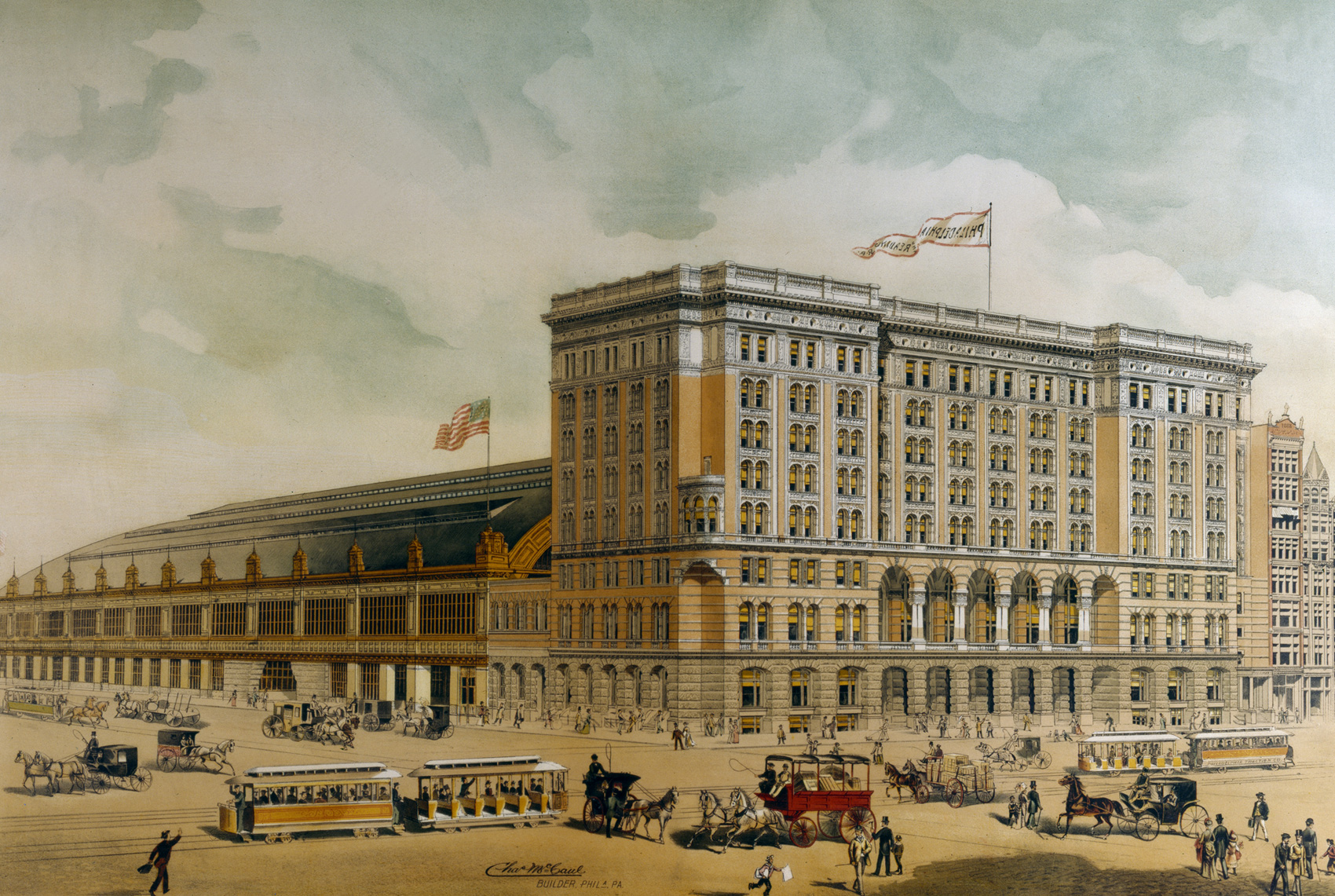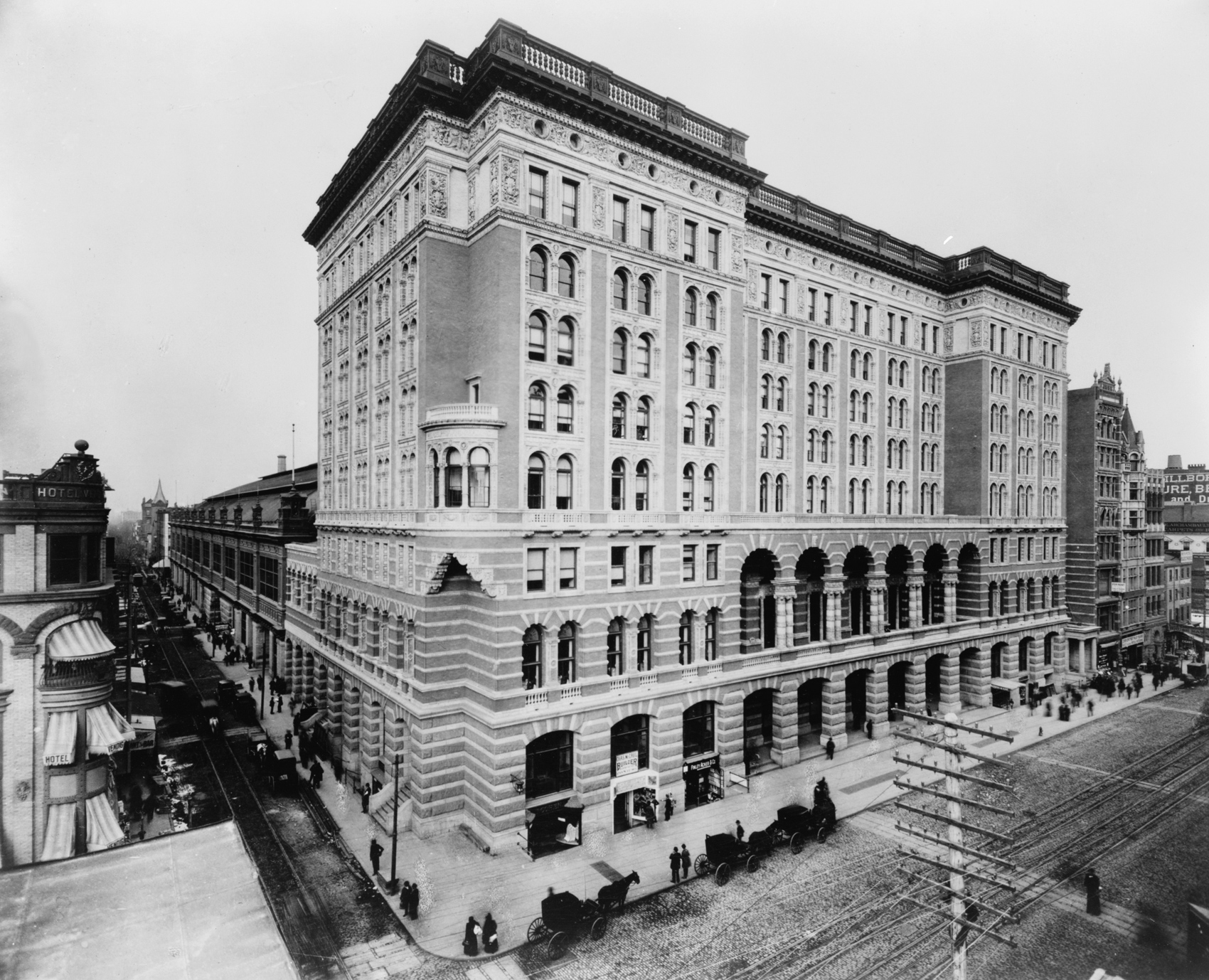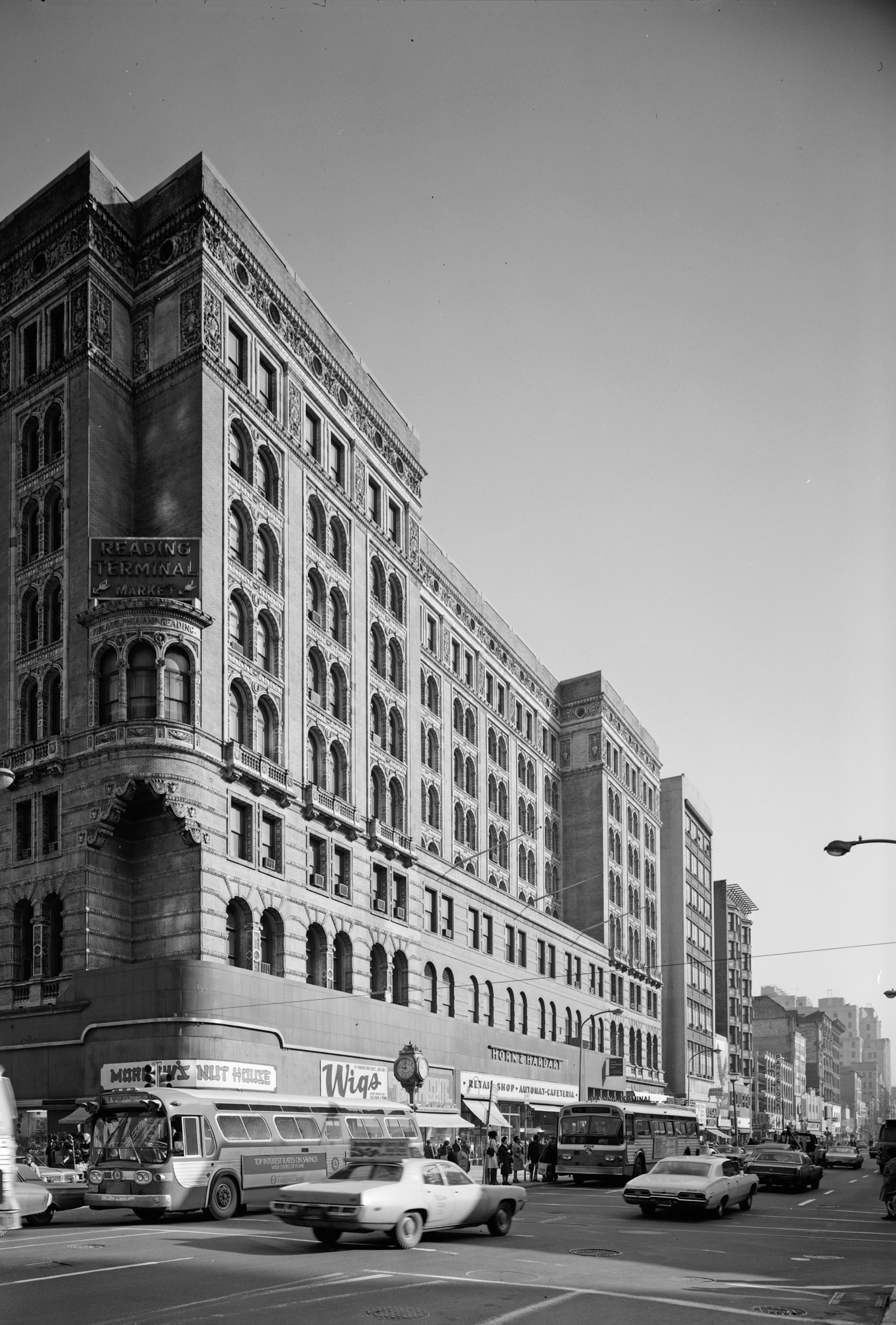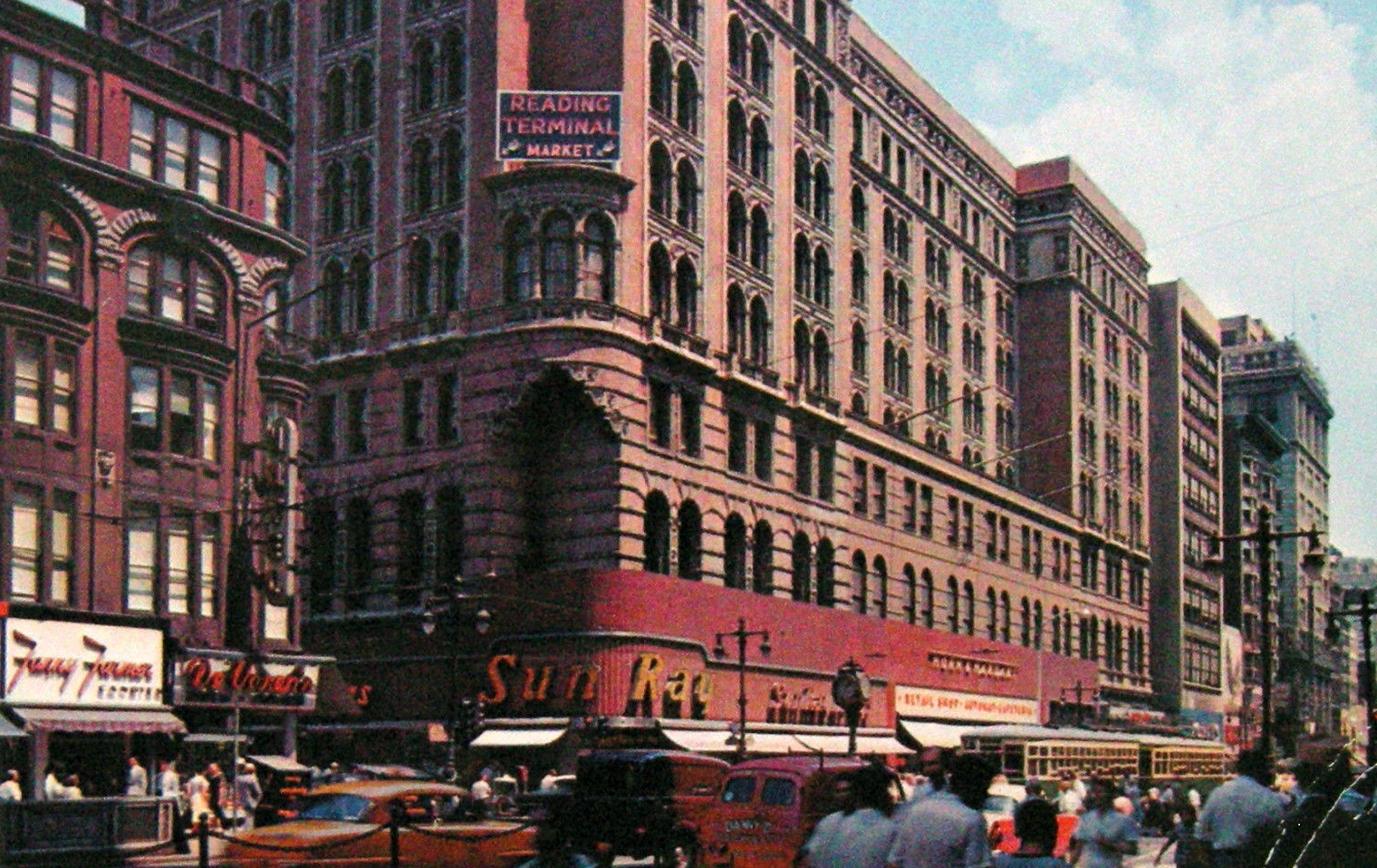Reading Terminal and Market: The Reading's Headquarters
Last revised: September 10, 2024
By: Adam Burns
The Reading Terminal and Market, located in downtown Philadelphia,
was the railroad's most famous and renowned station.
Along with functioning as a passenger facility the complex also served as Reading's main headquarters until it declared bankruptcy during the early 1970s and later became part of Conrail.
While the Reading was never truly large enough to be a major competitor in the intercity passenger market it did field one famous streamliner during the "Silver Age," the regional Crusader, serving business clientele between Philadelphia and Jersey City/New York.
The building's greatest asset was in commuter service as the railroad moved thousands on a daily basis within Philadelphia and its surrounding suburbs.
Today, this impressive complex still stands including its remarkable train shed as an extremely popular market and convention center.
In addition, it has been honored with the rare distinction as a National Historic Landmark, forever protecting its future.
 A lithograph by Charles McCaul of Reading Terminal around the time it opened for rail service on the Philadelphia & Reading.
A lithograph by Charles McCaul of Reading Terminal around the time it opened for rail service on the Philadelphia & Reading.History
The Reading Railroad has an interesting albeit somber corporate history. It was formed during the early days of the industry and blossomed into the Northeast's most powerful regional system thanks to Anthracite coal.
This clean burning, very hard type of black diamond is largely centralized in Northeastern Pennsylvania and the Reading would eventually captured three-quarters of the market by the late 19th century.
It began as the Philadelphia & Reading, chartered on April 4, 1833 by the Pennsylvania legislature to construct a line along the Schuylkill River.
Its first major achievement occurred in 1838 when it opened for service between Reading and Pottstown while a link to Philadelphia was established a year later.
By 1842 the P&R had opened northwesterly to Pottsville, operating a 93-mile route which became its primary main corridor.
The city of Philadelphia was established as its primary headquarters although Reading, Pennsylvania was always its operational nerve center with branch lines radiating in all different directions.
At its peak the railroad operated nearly 1,500 route miles, most of which were branch lines acquired by purchasing smaller systems.
Its notable predecessors included:
- Lebanon Valley (purchased in 1858 linking Harrisburg)
- East Pennsylvania Railroad (an 1869 takeover providing service to Allentown)
- Philadelphia, Germantown & Reading (leased in 1870 connecting Norristown)
- Catawissa, Williamsport & Erie (purchased in 1872 linking Williamsport)
- North Pennsylvania Railroad (an 1879 takeover that gave P&R access to Bethlehem and Yardley)
- Delaware & Bound Brook (leased around the same time as the NPRR to provide a connection with the Central Railroad Of New Jersey at Bound Brook Junction/Manville, New Jersey)
- In 1893 the Atlantic City Railroad provided access to Camden and Atlantic City.
The P&R would later consolidate this latter operation with the Pennsylvania Railroad's services in southern New Jersey forming Pennsylvania-Reading Seashore Lines, which became an important commuter system. T
he Reading would also open western extensions beyond Harrisburg reaching Shippensburg, Lurgan, and Gettysburg where it established interchanges with the Baltimore & Ohio and Western Maryland.
In addition, the railroad connected with virtually all of the Northeast's other important anthracite roads such as the Lehigh Valley, Lackawanna, and Erie.
In 1890 Archibald McLeod was elected president, by which time the P&R was a powerful and wealthy railroad thanks to its dominance of the anthracite fields.
Under his direction the company looked to transform itself into the Northeast's most powerful system.
It acquired several large lines including the Lehigh Valley, Jersey Central, and Lackawanna with attempts to expand into New England.
To display its power and prestige McLeod ordered the construction of Reading Terminal, the railroad's grand entrance into its home city of Philadelphia.
While the Pennsylvania Railroad was a formidable opponent here, having already opened Broad Street Station (later replaced with 30th Street Station) and the Baltimore & Ohio Railroad unveiled its own facility (24th/Chestnut Street) in 1888, the Reading's new complex rivaled that of its neighbors.
Located at the corner of 12th and Market Streets construction on the terminal began during the early 1890s.
It was designed in two distinct phases; the concourse and head house was the creation of architect Francis H. Kimball while the Wilson Brothers Architecture & Engineering Company oversaw the train shed and approaches.
For trains to reach the terminal the railroad built a massive raised viaduct (known as the Reading Viaduct) one-story above the street.
In a situation that was almost surely unique to this terminal the railroad came under serious opposition from local public markets then located at appropriately named Market Street. Even by the late 19th century the city had a long history with street venues.
According to the Reading Market's website the first impromptu markets opened near Front and High (Market) Streets in 1680 after farmers and fisherman brought their goods in for sale from southern New Jersey.
As the years passed the system became better structured and organized with city passing ordinances to oversee their operation. By the 19th century they were a well-established part of Philadelphia life.
During 1890 the Philadelphia & Reading acquired the 1110 block of Market Street with intentions to consolidate its four smaller depots within city limits into one large, centralized terminal.
This decision, of course, caused an incredible uproar by local vendors who refused to have the market relocated.
In the end the P&R and merchants compromised by having the market situated beneath the building's train shed and staging track. This plan wound up costing the railroad an additional $1 million.
Reading Terminal was designed in the Italian Renaissance style featuring three sections; the head house (an eight-story structure), balloon train shed, and the underground market.
According to Brian Solomon's, "Railway Depots, Stations & Terminals," the architectural segmentation had first been employed by London's famous St. Pancras Station. T
he terminal's interior was quite ornate with marble used throughout, featuring wood flooring and cast iron decorations while the exterior was adorned in pink granite with white granite trim giving the building natural color without using paint or other pigments.
The terminal opened to the general public on January 29, 1893. Given the timing of the its construction the station witnessed the grand "Golden Age" of passenger rail travel, which occurred from the start of the 20th century through the 1920s.
Despite its heavy use as a commuter facility the building did see a handful of regional, intercity trains. Along with the Crusader these included others like the King Coal, North Penn, Schuylkill, and Wall Street.
During the 1930s the Reading began electrifying its suburban lines within the greater Philadelphia region extending from downtown Reading Terminal to Norristown, Chestnut Hill, Doylestown, Hatboro, and West Trenton. Interestingly, even as late as the 1960s it was continuing to expand these operations!
Ironically, the opening of Reading Terminal signaled the end of the company's dominance and wealth. The financial Panic of 1893 brought down the Philadelphia & Reading empire.
The newly formed Reading Company rose from the ashes and despite losing control of its New England properties and most others in the Northeast it held onto the core P&R network.
It later acquired control of the Jersey Central before coming under the direction of the much larger Baltimore & Ohio.
Through World War II Reading Terminal saw several thousand travelers on a daily basis. Alas, as the 20th century progressed the railroad suffered from declining passenger and freight traffic.
The latter paid the bills and as anthracite coal dried up the company fell on hard times by the 1960s. The merger of the Pennsylvania and New York Central, creating Penn Central, was a disaster.
The conglomerate declared bankruptcy in 1970 and brought down most other Northeastern railroads with it. The Reading filed for reorganization on November 23, 1971.
After the creation of Conrail in 1976 (in which the Reading was included) the terminal continued to see use under SEPTA (the Southeastern Pennsylvania Transit Authority) until 1984 when a new structure, Market East Station, replaced it.
Following this change the elevated approach track connecting the terminal with the Reading's network were abandoned and partially demolished. However, the station itself would suffer a better fate.
In 1976, it, along with its train shed were forever protected when they were named a National Historic Landmark (it had partially been saved in 1972 when named to the National Register of Historic Places).
Today, the complex is part of the Pennsylvania Convention Center's main headquarters. While trains have not served the terminal for more than three decades now the Reading Viaduct is still mostly intact, albeit derelict and abandoned.
Inside the terminal visitors can glimpse what it must have been like to catch a train decades ago.
Aside from its preserved architecture a huge mural adorns one wall depicting the Crusader and a "Camelback" locomotive operating in commuter service beneath the massive train shed.
In addition, the market's logo features the classic Reading diamond complete with its company colors of green and gold.
Today, the Reading Terminal Market is a multi-use building that includes, hotel space, shopping, restaurants, meeting rooms, and of course the Reading Market.
So, if you are ever vacationing in Philadelphia, along with visiting 30th Street Station, this is another historic railroad landmark that you do not want to miss seeing!
One a final note, if you happen to watch Andrew Zimmern's "Bizarre Foods" program on the Travel Channel he stopped by the Reading Market.
Despite the fact that it has lost its status as a train station the building is still abuzz with activity and very popular. To visit the market's official website please click here.
Recent Articles
-
Nevada's - Murder Mystery - Dinner Train Rides
Jan 07, 26 02:12 PM
Seamlessly blending the romance of train travel with the allure of a theatrical whodunit, these excursions promise suspense, delight, and an unforgettable journey through Nevada’s heart. -
West Virginia's - Murder Mystery - Dinner Train Rides
Jan 07, 26 02:08 PM
For those looking to combine the allure of a train ride with an engaging whodunit, the murder mystery dinner trains offer a uniquely thrilling experience. -
Kansas's - Murder Mystery - Dinner Train Rides
Jan 07, 26 01:53 PM
Kansas, known for its sprawling wheat fields and rich history, hides a unique gem that promises both intrigue and culinary delight—murder mystery dinner trains. -
Michigan's - Wine Tasting - Train Rides
Jan 07, 26 12:36 PM
In this article, we’ll delve into the world of Michigan’s wine tasting train experiences that cater to both wine connoisseurs and railway aficionados. -
Indiana's - Wine Tasting - Train Rides
Jan 07, 26 12:33 PM
In this article, we'll delve into the experience of wine tasting trains in Indiana, exploring their routes, services, and the rising popularity of this unique adventure. -
South Dakota's - Wine Tasting - Train Rides
Jan 07, 26 12:30 PM
For wine enthusiasts and adventurers alike, South Dakota introduces a novel way to experience its local viticulture: wine tasting aboard the Black Hills Central Railroad. -
Kentucky Thomas The Train Rides
Jan 07, 26 12:26 PM
If you’ve got a Thomas fan in the house, Day Out With Thomas at the Kentucky Railway Museum is one of those “circle it on the calendar” weekends. -
Michigan's Thomas The Train Rides
Jan 07, 26 12:10 PM
If you’ve got a Thomas fan in the house, few spring outings feel as “storybook-real” as Day Out With Thomas™ at Greenfield Village in Dearborn, Michigan. -
Texas Dinner Train Rides On The TSR!
Jan 07, 26 11:36 AM
Today, TSR markets itself as a round-trip, four-hour, 25-mile journey between Palestine and Rusk—an easy day trip (or date-night centerpiece) with just the right amount of history baked in. -
Iowa Dinner Train Rides In Boone!
Jan 07, 26 11:06 AM
If you’ve ever wished you could pair a leisurely rail journey with a proper sit-down meal—white tablecloths, big windows, and countryside rolling by—the Boone & Scenic Valley Railroad & Museum in Boon… -
Wisconsin Dinner Train Rides In North Freedom!
Jan 06, 26 10:18 PM
Featured here is a practical guide to Mid-Continent’s dining train concept—what the experience is like, the kinds of menus the museum has offered, and what to expect when you book. -
Pennsylvania Dinner Train Rides In Boyertown!
Jan 06, 26 06:48 PM
With beautifully restored vintage equipment, carefully curated menus, and theatrical storytelling woven into each trip, the Colebrookdale Railroad offers far more than a simple meal on rails. -
North Carolina ~ Murder Mystery ~ Dinner Train Ride
Jan 06, 26 11:26 AM
While there are currently no murder mystery dinner trains in the Tarheel State the Burgaw Depot does host a murder mystery dinner experience in September! -
Florida's - Murder Mystery - Dinner Train Rides
Jan 06, 26 11:23 AM
Florida, known for its vibrant culture, dazzling beaches, and thrilling theme parks, also offers a unique blend of mystery and fine dining aboard its murder mystery dinner trains. -
New Mexico's - Wine Tasting - Train Rides
Jan 06, 26 11:19 AM
For oenophiles and adventure seekers alike, wine tasting train rides in New Mexico provide a unique opportunity to explore the region's vineyards in comfort and style. -
Ohio's - Wine Tasting - Train Rides
Jan 06, 26 11:14 AM
Among the intriguing ways to experience Ohio's splendor is aboard the wine tasting trains that journey through some of Ohio's most picturesque vineyards and wineries. -
Connecticut's Thomas The Train Rides
Jan 06, 26 11:06 AM
For 2026, the tour stop at Essex brings Thomas (and Percy, too) to the historic Valley Railroad for a full day of events for the kids. -
Maryland's Thomas The Train Rides
Jan 06, 26 11:00 AM
In 2026, the B&O Railroad Museum in Baltimore welcomes the Let’s Rock, Let’s Roll Tour with four event days that combine a Thomas-themed excursion with other activities. -
Tennessee's Thomas The Train Rides
Jan 06, 26 10:51 AM
Set on the grounds of one of the Southeast’s best-known operating railroad museums, the Thomas the train event blends kid-friendly fun with the unmistakable sights, sounds, and atmosphere of a real wo… -
Georgia's Thomas The Train Rides
Jan 06, 26 10:44 AM
Day Out With Thomas is set to roll back into Cordele in 2026, bringing Thomas the Tank Engine and a full family festival to the SAM Shortline at Georgia Veterans Memorial State Park.























